The female Belted Kingfisher near the Jordan River continues to engage me and my camera. Yesterday I was just about to leave the area after a half hour of waiting for her (I had actually started my pickup and was pulling away) when I heard her rattling call. The highlight of my time with her was when she cast a pellet with my lens trained on her. I’ll include images of the behavior below but first, a primer on pellet-casting in Belted Kingfishers (summarized from BNA Online):
- Like most fish-eating birds, kingfishers don’t have a crop and their thin-walled gizzard is incapable of vigorous grinding. Nestlings can and do digest all scales and bones of the fish they eat but by the time they fledge digestion of bones and scales ceases so they must throw pellets that consist of entire fish skeletons and scales (and the exoskeletons of any arthropods that have been eaten). It is believed that this change in digestive abilities is due to gastric secretions becoming less acidic and more alkaline in older birds. Belted Kingfisher pellets are compact and keep their shape for days so they’re a valuable tool in the study of kingfisher diets.
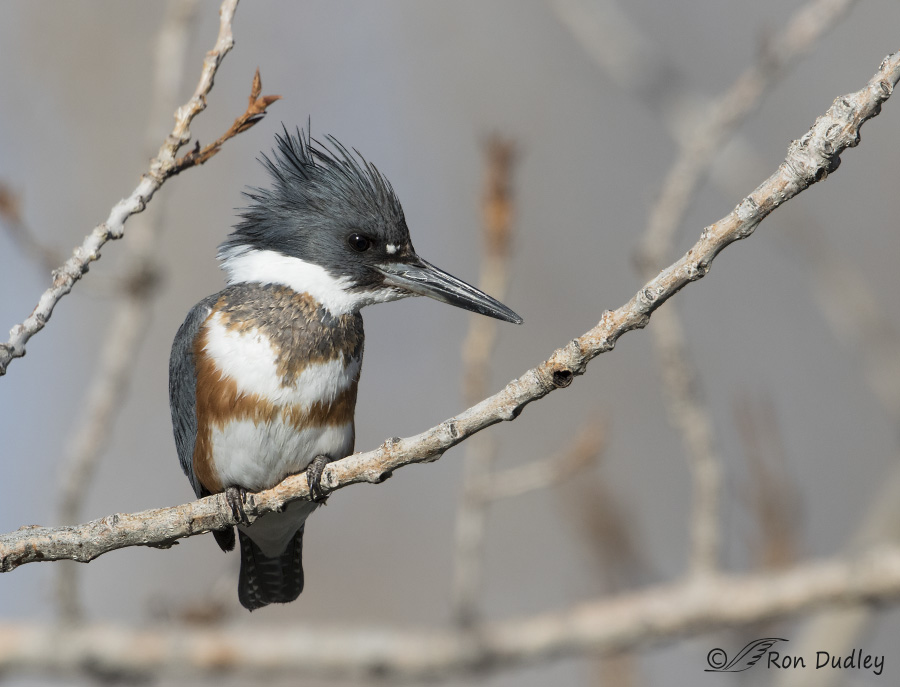
1/3200, f/6.3, ISO 500, Canon 7D Mark II, Canon EF 500mm f/4L IS II USM + 1.4 tc, not baited, set up or called in
She flew in close to me right at the beginning of my time with her and hunted from this relatively clean perch for quite a while.
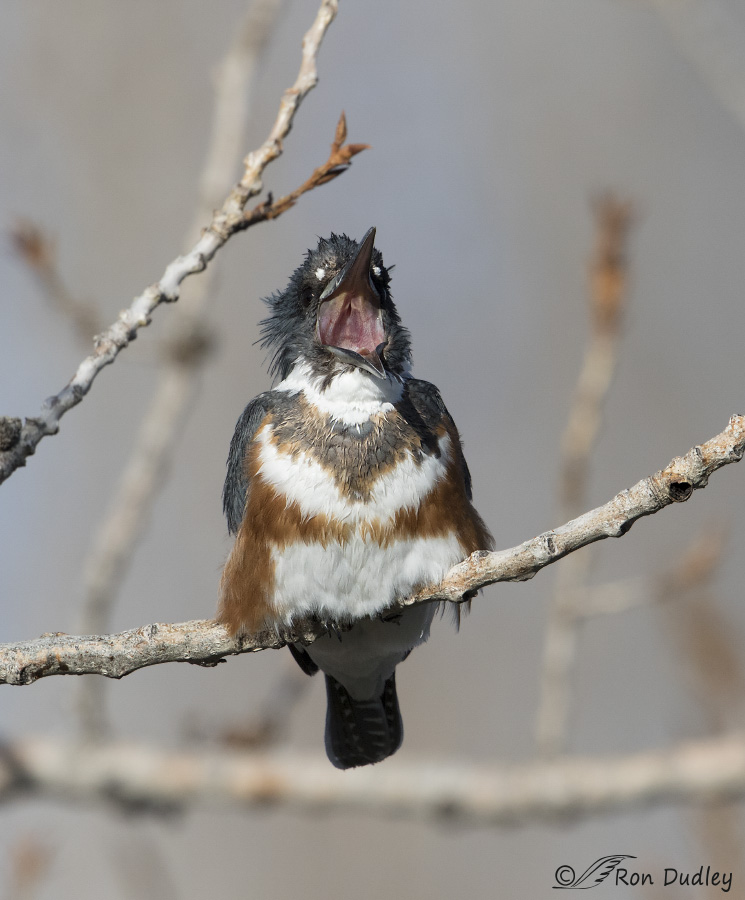
1/3200, f/7.1, ISO 500, Canon 7D Mark II, Canon EF 500mm f/4L IS II USM + 1.4 tc, not baited, set up or called in
Soon it became obvious that she was trying to cast a pellet. She retched like this several times but throwing a pellet is hard work and she wasn’t successful while she was on this perch.
Can you imagine how many fish have met their demise sliding down that gaping throat?
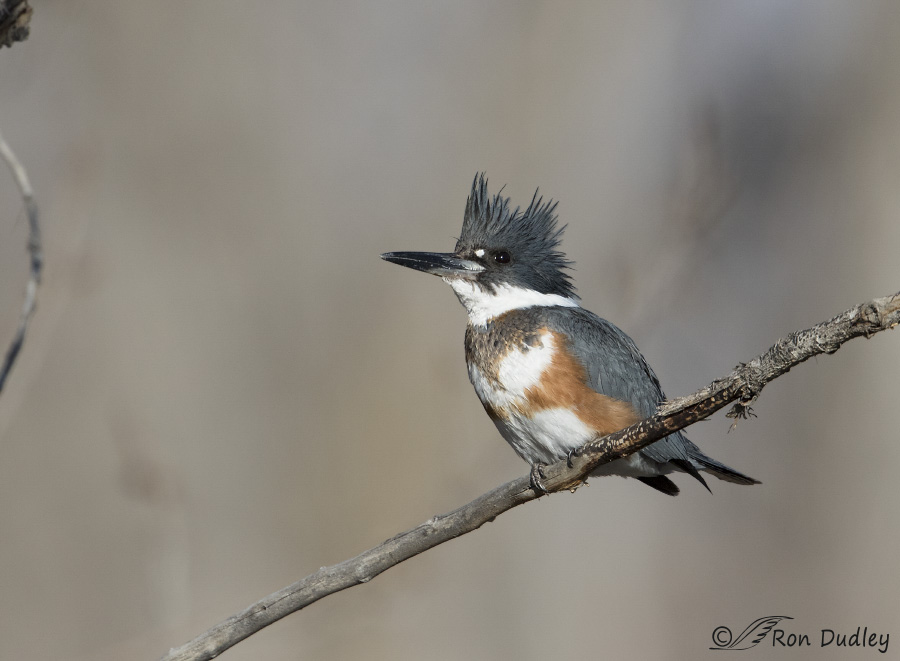
1/4000, f/6.3, ISO 500, Canon 7D Mark II, Canon EF 500mm f/4L IS II USM + 1.4 tc, not baited, set up or called in
I had a clean look at her on her next perch but she was much further away so these last images have been cropped significantly. Soon she began retching again so I fired off another burst but when it was over I didn’t know if she had cast a pellet or not because the process is very fast, she was far away and I often miss noticing quick bird behaviors through my lens because of the slapping shutter interfering with what I’m seeing.
When I arrived home and reviewed my images I was pleasantly surprised by what I had captured.
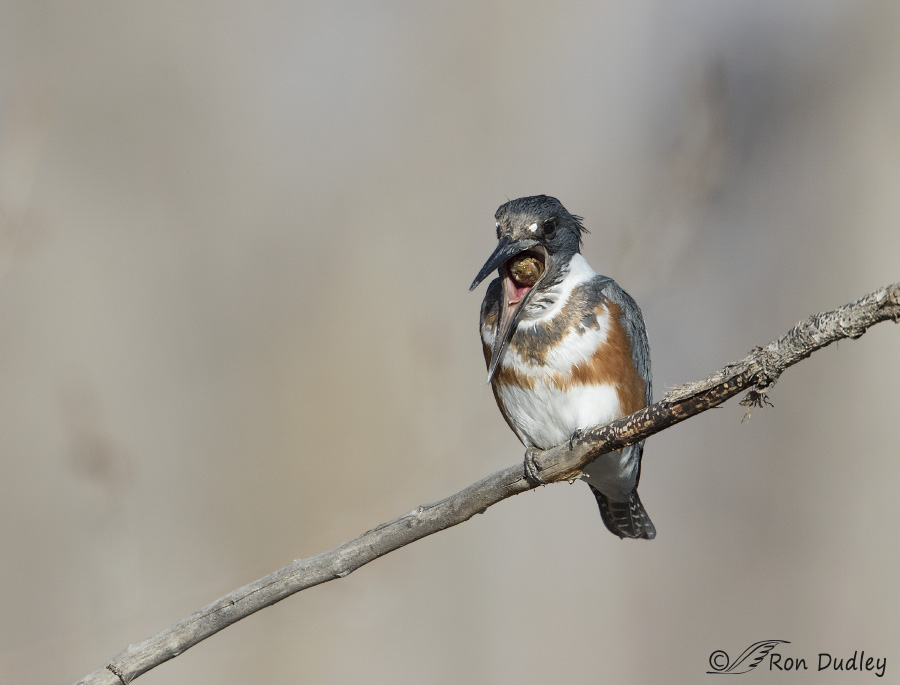
1/2500, f/6.3, ISO 500, Canon 7D Mark II, Canon EF 500mm f/4L IS II USM + 1.4 tc, not baited, set up or called in
Here we see a pellet in the back of the throat and beginning to emerge.
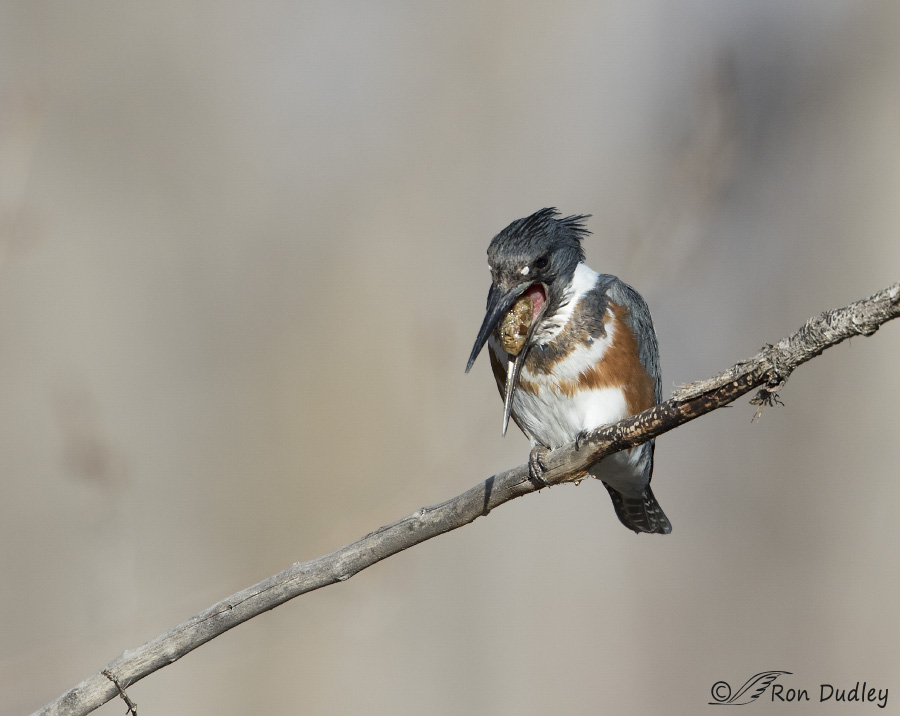
1/2500, f/6.3, ISO 500, Canon 7D Mark II, Canon EF 500mm f/4L IS II USM + 1.4 tc, not baited, set up or called in
It’s almost out…
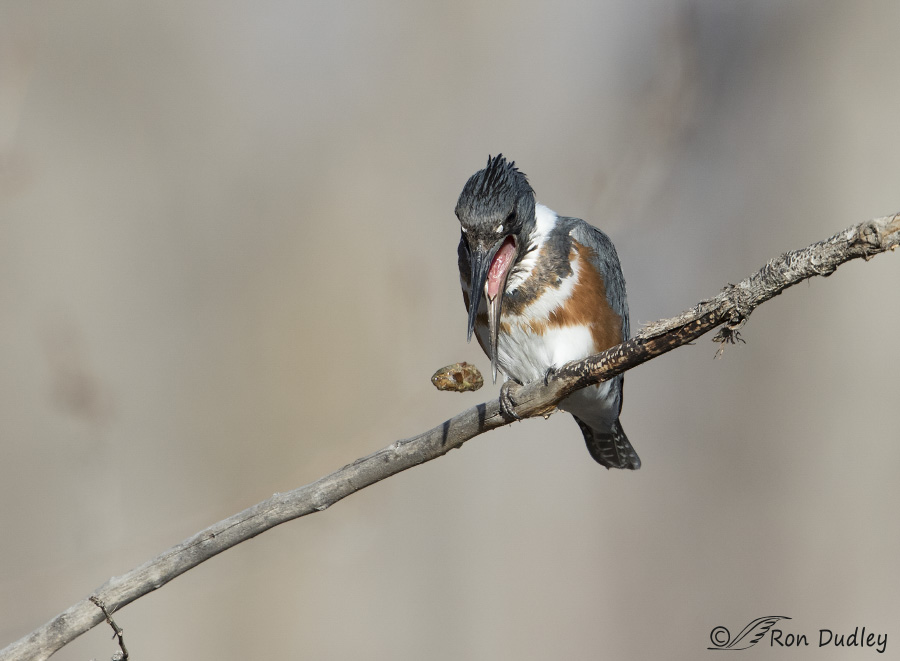
1/2500, f/6.3, ISO 500, Canon 7D Mark II, Canon EF 500mm f/4L IS II USM + 1.4 tc, not baited, set up or called in
In this shot I was happy that the pellet has neither the bird or the perch behind it which makes it clearly seen. I also enjoy the shadows of both the upper and lower bill-tips on the perch.
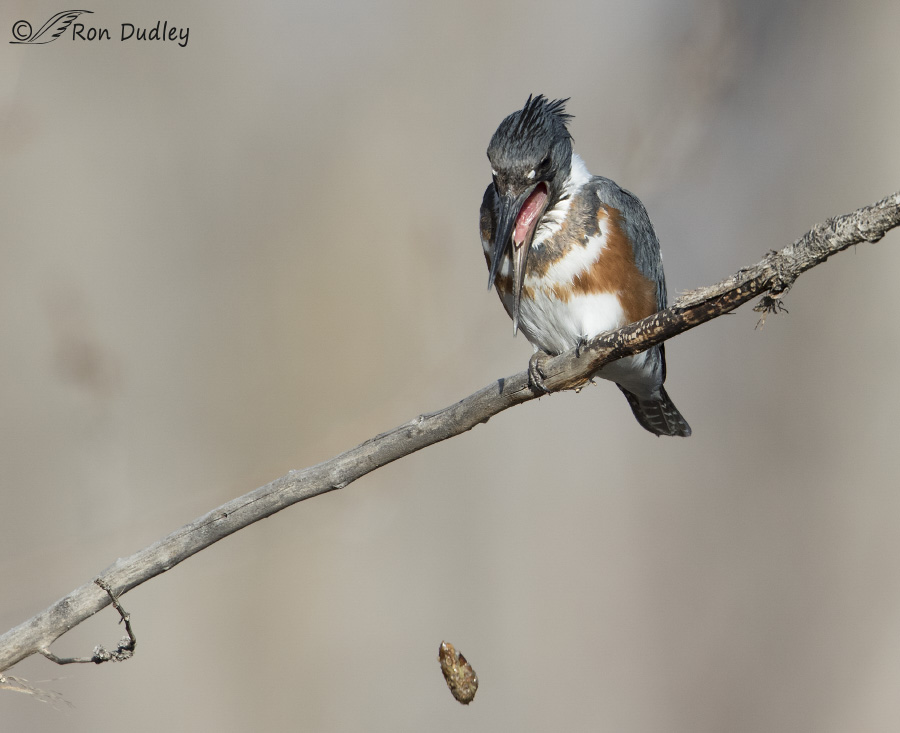
1/2500, f/6.3, ISO 500, Canon 7D Mark II, Canon EF 500mm f/4L IS II USM + 1.4 tc, not baited, set up or called in
This is the last shot I got of the falling pellet. It’s times like this that I’m appreciative of the fast burst rate of my camera (10 frames/sec). These last four images were taken in only .5 second (I’ve left out one image in the sequence). I’d have missed at least one of these shots with my older Canon 7D.
After the bird left this perch I wished I could retrieve the pellet for inspection but it had fallen into the water. Examining fresh pellets intrigues me (yes, I know about the possibility of them carrying disease), especially when they’re still moist and warm from the bird’s body heat. It’s something I’ve done before – an example can be seen here if you’re interested.
Ok, I keep promising to post something other than kingfishers and this time I mean it. Tomorrow’s post will be on another subject.
Probably…
Ron
Addendum: Laura Culley and I got into an unrelated but interesting conversation in the comments below about raptors shedding leg scales. She sent me a photo of scale plates that her Red-tailed and Harris’ Hawks have shed – a process that is new to me. I was interested in seeing them and I thought others might be too so I’ve added the photo below. Thank you, Laura.
 Copyright Laura Culley – Image used by permission
Copyright Laura Culley – Image used by permission


crazy amazing! i love how so often you are in the right place at the right time
and have the patience of a saint, i might add, waiting and waiting as you do….thanks, as always, for these photos!
Beautiful and very interesting series – down through the leg scales
How interesting about those leg scales!
Absolutely amazing shots Ron!Thanks for sharing!
Charlotte
It was such fun seeing this cute little bird the last few days. She is a sweetheart and I think she must like you too. As always you photos are wonderful. I loved the photos of the pellet coming out. It is very hard to catch them. I know this is cheating, but the only way I can capture the event is by recording it and then slow it down when processing.I hope this Kingfisher keeps making herself available to you.
The pellet shown in the link seems HUGE!
Thank you Ron – and Laura.
I do love learning. And beauty. And laughter. And often get all three here in this ‘one-stop shop’.
On the ‘clean’ front. I suspect that the current focus on disinfecting EVERYTHING is part of the reason that children (and adults) are so much more suceptible to many things. Good clean dirt is invaluable in building a healthy immune system.
And I would be retching if I had a pellet that big stuck in my craw.
“Good clean dirt is invaluable in building a healthy immune system”
There’s more than a little truth to that, EC.
Ah yes, EC, I used to eat a lot of dirt, crayons, paste and who knows what else along the way! I kiss my dogs on the lips, too. Kinda like Louise, I never wear gloves and the other day after hunting, I stopped at the grocery store to get some donuts for the next morning. There was the powdered sugar issue thing going on, so I licked my fingers, only after realizing there was mouse (or vole, whatever) blood and guts there. Oh well. Still haven’t fallen over dead, but I might soon. I’m old now so you never know. 😀
And yes, there are the over-active litigious parents to consider, but if you’re going to be MY apprentice, you’re going to have to learn to get over it because I get all cranky when I hear that EWWWW sound as it pertains to the birds–and dogs too for that matter.
Add me to the list of dirt eaters. And crayons. And paste. And paint. And whatever. I played with mercury too. Learned to walk pulling myself up on our German Shepherd’s tail and teethed on his ears.
And, while my immune system is shot now (MS) I suspect I would be MUCH worse off if I hadn’t had my happily grubby early start to life.
I learned to walk by pulling myself up on my grandmother’s German shepherd, too!! To this day, GSDs are at the top of my list of favorite dogs (with a couple of others).
Spectacular series, Ron! Simply spectacular!
Thank you, Diane.
Hi Ron
I am a subscriber of a French magazine “La Hulotte” and it was from it that I took the information that I gave you the other day about the Kingfisher behaviour. With your Kingfisher series I was able to actually “see” what I already knew from reading that magazine.
Your photos are wonderful and very very educational. It’s like putting together the best of two worlds and I thank you heartily for it.
If you want to know more about that French magazine you can Google “In troubled magazine world “La Hulotte” is one rare bird”.
Thanks very much, Jorge. As an ex-teacher I’m a firm believer that additional experience, above and beyond “book-learnin'”, is essential to understanding and helping it all to sink in. Your comment further confirms that.
Ron – Do you really think there is disease potential in handling a pellet? I know commercial pellet suppliers like Carolina Biological Supply or Pellets Inc ‘sterilize’ their pellets in some way, but I’ve always wondered if, given the high acidity of stomach juices and the fact that there’s not really any tissue left in them, there is a risk. Just curious, really. I never see flies attracted to the ones our birds disgorge; I have seen chickadees enter the great Horned owl enclosure (at great personal risk) to tear apart and carry off pellet contents – feathers or hair – for nesting, just like they pluck dog hair off my back porch mat. If we don’t freeze the pellets we collect for our activities (and we only use wild owl pellets, since they are more interesting than those from our birds), moths eventually get into them and they ultimately fall apart, but they never otherwise attract the types of insects or grub that aid in decomposition of carrion. And we do give kids non-latex gloves to wear (which they seem to enjoy as much as the pellet dismemberment) – but we don’t do anything else to sterilize them. Anyone’s thoughts much appreciated. Thanks.
Louise, it’s my understanding that the potential danger from pellets is Salmonella contamination (either from the bird or the prey whose parts formed the pellet).
In the old days (before this possible danger was known or publicized) my students and I handled owl pellets for years without any problem. It really doesn’t concern me much personally but if I were still teaching I’d probably play it safe and use sterilized pellets for my students.
Hey Louise! For whatever it’s worth, many of those store-bought pellets aren’t real pellets at all, but manufactured lookalikes (kinda). I’ve been handling real pellets for 22 years now, regularly, and I’ve never had any bad things happen. I’m not all that good at remembering to wash my hands, either. I haven’t died yet, but it could still happen 🙂 In MY world, I think there’s something wrong with us that we think we need to be over-the-top sterile, but again, that’s just me and I used to break thermometers open and play with the mercury in my hands. That might explain a lot, or not. Who knows? Too late now!
I agree with you, Laura – we’ve become paranoid about “germs”, at least too some extent. The only reason I’d be careful now with students is because of lawsuit-happy parents.
I also used to play with mercury but I’m no “mad hatter” yet, I hope…
Ah, mercury! Me, too! Actually I hadn’t thought of salmonella, which is a fecal-oral transmission, so must somehow get through the GI tract intact to be passed on to the next victim. But, like both of you, after 30 years in this business, I figure I have one heck of an immune system because I don’t wear gloves for much of anything, even necropsies, for the most part. Unless someone is watching! grin. And haven’t ever gotten sick. Though we put zoonotic information into all our volunteer introductory packets, so they know there are risks. Thanks.
Laura, I’m an old guy and when I was a kid I used take mercury and rub it on coins or play games with it. So far I’m still here!
WOW! Look at the size of that throat!! As well as the pellet! What size would you judge the pellet to be? No wonder it takes such effort to expel! Fantastic shots!
I will look for the place you mentioned in your previous post of where to look for kingfishers off I-15. Thanks!!
PS I’m curious. About how far were you from the kingfisher in the first image? Your lens is a wonder to me!
Jane, I’d only be guessing about the size of the pellet so I hesitate to do so.
I’d estimate that I was about 50′ from the kingfisher in that first shot – that’s very close for a kingfisher. And yes, my lens is a wonder to me too!
Fascinating! Can you guide me to a resource for the info on the change in dietary pH with maturation? The same seems to be true of owls, as well, and I would love to read details.
Sallie, BNA cites the following source for that information. Sorry, that’s all I know about the source.
White, H. C. 1939a. Change in gastric digestion of kingfishers with development. Am. Nat. 73:188-190.
Thanks, Ron. I found the citation and one other. I’ll look into getting hold of them. The question interests me because young birds need so much calcium during their speedy growth to mature size, and so it’s interesting that owls, whose pellets as adults indicate not much in the way of bone absorption, have that acidic gastric fluid as babies when they really need it. Guess kingfishers are like that as well. Birds are really the most remarkable creatures.
I had no idea. I love posts like this and your photos are fabulous. I share information like this as often as I can. Thanks for adding to my knowledge.
I shared the post on my facebook page.
“I shared the post on my facebook page.”
Good. Thanks, Kathy.
I never cease to learn something from your posts! I didn’t know that kingfishers expelled pellets! I read your other post, and it reminded me, again, about making assumptions!
Yup, making assumptions is often a potential trap, Brenda. I still do it but I’m way more careful about it than I used to be.
Hi Ron,
W.O.N.D.E.R.F.U.L. I have seen LOTS of kingfishers (mostly because I am so old), but I have never observed this behavior. And, to use a word frequently seen in your comments, “fascinating”!
Your continuing student,
Dick
The behavior is easy to miss, Dick. It often happens very quickly and if you don’t spot the open beaks and retching first it’s happened before you know it. Lots of folks think the open beaks are because they’re yawning when it often isn’t.
Great series – always wondered about the change in pH and the thin-walled gizzard, still do wonder why bones don’t puncture it.
Fascinating stuff, a lot like taking apart owl pellets. Use to use Owl Pellets in class!
Many thanks for sharing – these are some fantastic shots!
“Use to use Owl Pellets in class”
So did I, Dick. They’re a great teaching tool.
And I wonder the same thing as you do, especially knowing how sharp some fish bones are.
Wow, Ron – wonderful blogs – both your sassy little Kingfisher and the Swainson’s Hawk from 2012!! I loved both the capture of the birds themselves and the pellets they coughed up. I can really feel for them since it’s not one of my favorite thing to do in times of illness!!! These poor birds have to do it on a regular basis – ugh!! The photos you got of the Swainson’s Hawk definitely showed how difficult it is for them to expel a pellet (or 2)!! Again, the eagle cams have taught me how early in life an eaglet has to deal with pellets and it just blows my mind at the size they have to cough up. It sure would put me off solid food – LOL!! Makes me appreciate how much easier my life is compared to what all our wonderful wildlife has to deal with to survive. We humans should be making life easier for them – not harder!!!
I REALLY don’t like to throw up, Jo Ann (I’m going to tell you more than you want to know here).
I haven’t vomited since I was 7 years old (61 years ago) and had pneumonia – damn, I was sick! I hate it so much that even when I’m sick I fight it. I didn’t even let it happen as a young man when I drank too much beer :). I’d have felt much better if I had vomited so fighting it isn’t really very smart.
Again, you’ve capture a wonderfully interesting behavioral series. The size of that pellet is surprising. I wonder how often they cast theses things….
I didn’t realize that fish-eating birds did not have crops…I’ve always thought ALL birds did!!! Who knew……
“The size of that pellet is surprising”
Agreed, Patty. I suspect that’s at least part of the reason many birds have such difficulty expelling pellets. I don’t know how often they cast them.
I have been enjoying the Kingfisher photos tremendously Ron. Such a distinctive call. News to me about this bird casting pellets.
Here’s an amusing story about pellets. I took my friend’s two young sons on a nature hike and we found a longtime perch with considerable whitewash and pellets under a large branch. I’ll never forget the look of amazement and delight on those boy’s faces as I revealed the intact tiny skulls of the voles that they contained. One for each of them….. Don’t know how appreciative their Mom was though when the treasures were proudly displayed 🙂
Wow, Victoria!! I LOVED your story of the walk with a friend’s boys and the discovery of the pellets contents!! Great learning experience for them!!
I loved hearing your story about those boys and the pellets, Victoria. I hope it inspired awe and respect of raptors in both of those kids.
(Insert standing WOW! here plus a YOWZER!) I just love it when I learn new stuff. I had no idea that kingfishers cast pellets and oh how spectacular that you captured the entire sequence! WOW/YOWZER!
Personally, I LOVE inspecting castings, whether they’re wet (new) or dry (older) and I haven’t died yet. I do, however, wash my hands some of the time. Anyway, last year I was able to defend the local redtails in Ithaca with the Binghamton University professor who studies crows. I picked up abundant evidence under the Great Horned Owl nest they were routinely catching and eating crows and feeding them to their kids! She still doesn’t like redtails, though.
AND I have the first casting Mariah (female redtail hawk) ejected with me oh so many years ago. Did somebody say crazy? Yeah, and your silly point would be…? 😀
“I have the first casting Mariah (female redtail hawk) ejected with me oh so many years ago”
I like that sentiment, Laura. It’s not the same thing really but I still have the piece of barbed wire I cut away from the Barn Owl last summer after I cut it out of the fence. Every time I look at it I hope that owl’s still out there somewhere.
Yeah, you get it! I’m with you, hoping that barn owl is out there thriving and getting ready to raise a family now!
There’s also another keepsake I keep. Did you know that redtails and Harris’ hawks shed the scales on the front part of their tarsi all in one piece, kind of like a shield? It’s really pretty cool. I don’t often get to retrieve them, but yesterday I found one from Mariah. I’d guess all raptors and maybe other birds do that, but we just don’t KNOW they do that since they blend into the environment where they drop them and my only first-hand knowledge is from Mariah and Jack. I have a reasonably good photo of them, one from each of them. Just another one of those cool things they do.
No, I didn’t know that, Laura. It’s absolutely fascinating.
It makes sense though. Scales on reptiles must be shed as the animal grows and bird scales are pretty much the same as those on reptiles. Is Mariah a young bird? I wonder if those tarsi scales stop being shed once full growth is realized…
Nope, Mariah is 22 years old. Jack the Harris’ hawk is 16, so it’s not a juvenile thing. Also, I only find one at a time per year. So I’m wondering if they alternate. I’ll send the photo to you, PM on FB and feel free to share it from there (I’m NOT a computer geek). I have to find it first, though. It shouldn’t be far! They’re really cool.
Oh and the ones I’ve seen appear to be from the FRONT of the tarsus. Not sure if I’m just not finding the ones from the back, or if they only shed it like that in the front. Another one of life’s mysteries for me.
I am learning so much. I didn’t know that birds threw pellets. What is your favorite time of day for photographing birds, Ron?
I’m a morning guy, Elizabeth. Birds (and me) are most active in mornings and I prefer morning light. Probably about 95% of my bird photography is done in the morning. This kingfisher has been the exception because the light angle in this area is only good in the late afternoon.
Great sequence Ron, and I like you, would have loved to have been able to examine the contents of that pellet. ;-)))
Maybe next time, for both of us, Roger…
Cool! I had no idea they did this even if the owls sure do! Pretty large pellet for such a small bird – no wonder it was work! I often find things in photos I’ve taken that I didn’t realize were there at the time. 🙂 Thx for the biology lesson and great photo’s.
“I often find things in photos I’ve taken that I didn’t realize were there at the time”
Me too, Judy. For me that’s a big part of the appeal and the fun of bird photography.